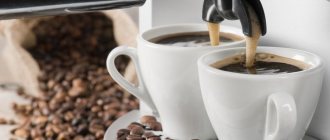Espresso is a coffee drink with a dense structure, thick foam and a pronounced aroma.
Espresso is the basis for most other coffee drinks and the final taste depends on the quality of its preparation.
Making the perfect espresso is a fairly complex process, but the art can be learned, it just requires knowledge of the basics and constant practice. The final taste of the drink is influenced by the following factors:
- type of coffee beans;
- cleanliness of equipment;
- water pressure and temperature;
- dosage of coffee used;
- tempering;
- extraction.
Before you start making espresso, we recommend that you familiarize yourself with these factors in more detail.
Variety selection
Special espresso blends and single origins are most suitable for making espresso.
These types of coffee require a special degree of roasting of the beans, which is usually slightly darker than other brewing methods. This contributes to a sweeter and more balanced taste in the finished coffee.
We do not recommend choosing a light roast that is used for other brewing methods. With beans of this roast level, espresso will be sharply acidic and its body will be watery.
What determines the foam on coffee?
Baristas say that lush and tasty foam is obtained in the presence of three factors:
- proper functioning of the cappuccino maker;
- quality ingredients;
- clean design details.
Here are some tips to make it beautiful and tasty.
- Choose good coffee. It should be oily and not shiny. Also, grains or ground powder must be sold in closed, opaque packaging with a valve.
- Try to buy Arabica. This variety has a large amount of essential oils, which give a properly prepared drink a delicate taste and aroma. Also, in combination with it, the foam becomes more fluffy.
- High foam appears due to fresh grinding. Therefore, it is better to buy the beans and grind them 10 minutes before making coffee.
- The quality of the foam is also affected by the liquid used. Try to use bottled non-mineral water.
- Give preference to coffee machines from trusted manufacturers. Do not buy cheap analogues, as the reliability of the device plays an important role.
- Clean structural elements at least once a week. Scale or other contaminants can get into the ingredients and affect the taste of the resulting drink.
Features of settings
You can find out how to adjust the foam in a coffee machine from the manufacturer's instructions. Typically, users do not change the factory settings. However, if you don’t like the standard foam density, they can be adjusted.
Before doing this, customer service staff recommend checking the ingredients used. The owner of the machine must ensure that the fat content of the milk is 2.5-3%. You can use a fattier product, but you must not forget to rinse the parts after each cooked portion.
Equipment cleanliness
Maintaining the cleanliness of equipment is very important, since its components become dirty quite quickly. Daily cleaning of the basket, holder, dispersion mesh from calcium and coffee oils will extend the life of the equipment and also improve the taste of the finished drink.
We recommend cleaning the internal surfaces of the holder and the dispersion mesh with special cleaning agents every 50 espresso shots, but at least once a day.
The coffee grinder can be cleaned daily with a regular brush and monthly with cleaning products.
How to adjust the foam in a coffee machine
Call the master
It’s very easy to submit a request for professional repairs - fill out the online form or call:
"A-Iceberg" - 27 years with you. 5,500,000 repairs completed.
The quality of a cappuccino or latte is largely determined by the taste and density of the milk foam. On most coffee machines, the user can independently adjust the milk frothing process, based on their own preferences. In this case, it is important to strictly follow the manufacturer’s instructions to avoid mistakes in the settings.
If your coffee maker breaks down, contact ECC A-Iceberg. Our technicians have extensive experience in servicing and repairing coffee machines from different companies: Delonghi, Saeco, Krups, Vitek and others. The work is carried out at the client’s home, without transporting the equipment to the service center. You can call a specialist by or by filling out an online application on our website.
Water pressure
To prepare delicious espresso, the water pressure in the coffee machine should be from 8.2 to 9 atmospheres. It is necessary to adjust the pressure immediately and use a pressure gauge to ensure that it does not go astray. To do this, you need to make a coffee tablet, insert the holder into the group and turn on the spill. At this point, you need to monitor the pressure and, if necessary, adjust it.
The process of setting pressure for each coffee machine occurs differently. You can use the services of a specialist or study the instructions.
Delicious espresso can be obtained both at lower pressure and at higher pressure. However, we recommend starting the espresso preparation process with the specified pressure range, since experiments with increasing or decreasing the pressure will only be successful if you have some experience in preparing espresso.
Diagnostics
Before any repair work, a device of any brand, for example: Jura or Nespresso, needs to be diagnosed and the problem area localized. Check the settings. Knowing how to increase the temperature, you can adjust it to the desired level. This information can be found in the instruction manual.
If the settings are correct, the device is disconnected from the power supply. Calling a technician will allow you to quickly deal with problems and return them to a stable working state. During the diagnostic process you will need:
- professional knowledge and skills;
- special tools;
- ability to work with different manufacturers and models;
- selection of high-quality and suitable components for replacement.
All qualities are present in service masters. By trusting specialists, customers receive prompt restoration of equipment with a guarantee.
Water temperature
When making coffee, water temperature is very important. There is no ideal value, but in any case the temperature should be in the range of 91-96 degrees Celsius.
With any method of preparation, except cold brew, light roast coffee is prepared at a temperature of 93-95°C, medium roast – 91-93°C, dark roast – 89-91°C.
| Light roast | 93-95°С |
| Medium roast | 91-93°С |
| Dark roast | 89-91°С |
We recommend preparing espresso at a temperature of 93°C. This is the standard that most modern baristas adhere to. When preparing espresso, the temperature is adjusted once and for a long time. And to adjust the taste, change the grind size or dosage of coffee.
Not all espresso machines have a temperature control function, as they are equipped with only one boiler with a heat exchanger. This boiler is used to prepare steam, boiling water and espresso at the same time. On such coffee machines, the temperature can be adjusted using a mechanical bolt on the pressure switch. Focus on the taste of the finished drink - if the coffee is sour, you need to increase the temperature, and if it is too bitter, lower it.
DIY repair
How to increase the water temperature in the device? In most cases, only a specialist can answer this question. It is possible to independently identify and eliminate only minor problems in the operation of the coffee machine. Many of them are not technical in nature, and therefore do not require practical skills. Simply follow the instructions.
| Defect | Elimination |
| Cold dishes | Try to warm up the cup before use. Some modern models of coffee makers already have a mug heating function, which greatly simplifies this process. |
| Lost settings | The recommendations indicate how to set the correct temperature for brewing coffee (approximately 90 degrees). It is possible that for some reason they have gone wrong, so you need to set the required values manually. |
| Scale | It should be cleaned exactly according to the instructions so as not to damage important elements of the device. |
| Long equipment downtime | When you have not used the equipment for a long time, you need to give it time to warm up after starting it. Otherwise, you won’t get a warm drink. |
Other problems require practical skills and theoretical knowledge about coffee machines. Therefore, you should entrust their correction to the employees of service centers.
Coffee dosage
Depending on what basket your holder has, the required dosage of coffee is calculated. Baskets can be single or double. A double tab is more convenient, since extraction in a double basket is more uniform and stable.
Double baskets can be of different sizes. We recommend using large capacity baskets with a dosage of 17-20 grams of coffee and using the amount of coffee whose weight is indicated on the grid.
It happens that there are no markings on the baskets. In this case, it is necessary to ensure that the coffee tablet does not reach the dispersion mesh of the coffee group. Make several tablets in a holder in 1 gram increments and insert them into the group without boiling until a slight imprint of the bolt or mesh remains on the tablet. Then reduce this weight by 3 grams - this will be the ideal weight for your holder.
At first, use a small kitchen scale with 0.1 gram increments for accurate measurements.
Flaws
It is worth noting that instant coffee drinks (in addition to their positive properties) have a large number of disadvantages. Experts do not advise people with cardiovascular diseases and stomach diseases to abuse this coffee due to the high caffeine content and high acidity.
But decaffeinated instant coffee drinks are also harmful to human health. It has an adverse effect on kidney function.
Therefore, no matter how good the taste of such a coffee drink is, you should not get carried away with it too often. Real ground coffee is much healthier and tastier. You can also brew ground coffee in a cup.
Distribution of coffee in the basket and tempering
Forming a “coffee tablet” or coffee bookmark is an important step in making espresso. Their interaction with water, and therefore the correct extraction of coffee, depends on how well and evenly the coffee particles are compacted.
Place the coffee powder in the holder and spread it over the basket with your fingers without pressing so that there are no lumps or mounds left. Achieve a smooth surface without cracks or cavities. Break up any lumps using a rotating motion using a leveler or toothpick.
Compacting the ground coffee is an important step in the process. Form a dense layer through which water will pass. When compacting lumps, it is very important to use even pressure to prevent the formation of channels. If water passes through holes rather than through the mass, the drink will turn out watery and tasteless.
Under no circumstances should you tap the tamper on the holder either before or after tempering - this will lead to the formation of channels and the espresso will turn out tasteless.
After distributing the coffee, you should compact it. To do this, you will need a tamper with a flat base and a diameter that matches the diameter of the holder basket as much as possible.
The effort you put into the tempering process should be minimal. Try to temper as evenly as possible, at a right angle, to avoid distortion of the coffee tablet. There are special push tampers with an edge limiter that solve the problem of skew and provide a consistently uniform level of tampering without requiring additional effort.
After tempering, remove the remaining ground coffee from the edges and walls of the holder so that the grains do not bake on the rubber gasket of the group.
Hardware faults
If you are sure that the drink was not prepared cold due to incorrect settings, then the reasons are hardware failures:
- The heating element is broken. It does not heat the water, because... burned out or the working resource has been exhausted. Due to power surges, the circuit leading to the heating element breaks. Without energy, he is not able to cope with functionality.
- Sensor malfunctions. They do not determine the temperature of the liquid and do not transmit information to the heating element. The heating element does not turn on. Most often the thermostat needs to be replaced.
- Oxidation of contacts. Symptoms: the technique works every other time. Sometimes control from the electronic board is transferred in normal mode. Complete oxidation of contacts leads to complete failure.
- The electronic module is broken. This is a small chip that contains all the intelligence.
- Vapor block malfunctions. Observed if the user likes coffee with foam. The system becomes overgrown with scale and needs to be cleaned.
- Damage to the electronic control unit. The device makes a cold drink and stops heating the water. The controller has broken down - the device through which energy is transmitted to start the heating element and all equipment in general. The part cannot be repaired and needs to be replaced.
The boiler breaks down gradually. First, the time required to prepare coffee increases. Taste characteristics and temperature decrease, and strength suffers. It is rarely possible to repair heating elements; it is often necessary to disassemble the equipment, disconnect the part, and install a new one. Independent actions are not recommended; you risk damaging an expensive device. The same is true with the thermostat.
Breakdowns of the vapor block are caused by the fact that the user does not keep this element in perfect condition. Timely maintenance solves the problem, because The product requires periodic cleaning. If it fails completely, replace the worn sealing rings. It is also advisable to perform the procedure at a service center.
The electronic filling is a complex technological system based on Bosch or Vitek. The coffee turns out cold because the device does not respond to user instructions or performs them incorrectly. The more modern the model, the smarter and more advanced it is. And the more complex the control board. Independent intervention leads to a worsening of the problem and an increase in the cost of repairs.
Extraction
Extraction is the process by which soluble substances from coffee are mixed with water. During extraction, the tonic properties of the drink, the aroma and taste that we love so much are revealed.
After tempering, the holder is inserted into the coffee group and the flow is immediately turned on. Delay in turning on the pour will cause the coffee in the holder to begin to burn due to the high temperature of the group.
Espresso extraction time – 25±3 seconds.
If you are using a coffee machine with a heat exchanger, then before installing the holder into the group, you need to spill 50-100 ml of water. This will lower the temperature to operating temperature. Wait until the boiling water stops hissing and start cooking.
If you have a double-boiler coffee machine, you also need to spill water. This is necessary to clean the mesh from old coffee residues. It is necessary to spill water until it becomes clean.
The final weight of the drink should be approximately 1.8–2.2 times greater than the amount of coffee used. For example, if the dosage of ground coffee is 18 grams, then the weight of the finished double espresso should be 32-40 grams. But it is necessary to take into account the fact that the ratio of the weight of coffee to the weight of water changes depending on the degree of roasting of the coffee.
If you are not satisfied with the speed of preparation of the drink, then you need to adjust the grind size. If the espresso is prepared faster, you need to reduce the grinding; if it is slower, increase it. You need to experiment carefully with the degree of grinding, as espresso reacts very sharply to this. Be sure to grind 1-2 coffees after adjustment so as not to use the previous grind remaining in the channel.
Start by making a standard 36g espresso shot using 18g of ground coffee in 27 seconds at 93°C. After that, you can experiment with the parameters as indicated above.
When preparing espresso, follow your own taste. If you deviate from the standard, but the drink turns out delicious, then you are doing everything right.
Aeropress manipulation
The AeroPress has two main functions: “pressure” (a tool for increasing the level of extraction) and filtration. Both functions are used every time you brew, but you can shift the emphasis. So, for example, using the direct method and pre-wetting, we form a tablet at the base of the Aeropress and, by squeezing water through the coffee, we try to get more out of it (relatively the espresso principle). Or another example: the inverted method, in which the coffee is passively extracted, and then, by inverting the Aeropress, we simply filter it from the coffee grounds. This works if you press down immediately after flipping, preventing all the coffee particles from sinking to the bottom.
I prefer recipes with a shift in emphasis towards “filtration”, when extraction proceeds as passively as possible (the coffee bean “decides” what to give to the water). The most effective way I know is to place coffee in water, not the other way around. A simple experiment: fill a transparent vessel with water and distribute a layer of coffee evenly over the surface. Water gradually penetrates into the structure of coffee particles, drawing out the taste from there. It is easy to notice how the color of the water changes during the extraction process.
This idea formed the basis of my approach to brewing at the Russian AeroPress Championship in 2021. The main point: into the AeroPress with coffee, water is drawn in from the container (like a syringe). As a result, it turns out that a coffee tablet lies on the “water column”, from which coffee substances gradually dissolve in water. In order not to delay the extraction too much, you can shake the Aeropress, thereby destroying the layer of coffee particles, and gently press. You can also increase the level of extraction and speed up the brewing process if you initially add a little water to the AeroPress chamber (a kind of pre-wetting).
Considering the different rates of dissolution of substances from coffee beans and using several brewing techniques in an AeroPress, you can control the taste and even get radically different drinks during one brewing. If you place the Aeropress in a direct way, add coffee and slowly pour water into it, wait until there is a volume in the server equal to 2-3 servings of the coffee being used (if you put in 20 grams, the output should be 40-60 ml of drink), close the chamber with the piston, Having thus interrupted the spill, infuse the remaining volume for one or two minutes and press into another container, you will get two drinks. The first will be bright, slightly sharp, reminiscent of espresso in its profile, and the second will be soft, sweet, but smooth without pronounced descriptors.
A little about stirring: it is needed to evenly distribute the coffee particles. As a way to increase extraction levels, external turbulence is not the best choice in my opinion. Active stirring negatively affects the taste of the drink and adds bitterness.
The intensity of pressing affects the taste and texture of the drink. The more force you have to press, the more oily the coffee turns out. In turn, the “resistance” is influenced by the grind size and how evenly the coffee particles are distributed in the water layer. It will be most difficult to press the Aeropress if you use finely ground coffee and vigorously mix it.











